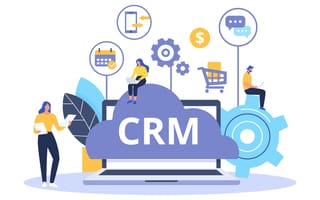If there’s one thing sales teams aren’t lacking for these days, it’s tools. There are tools for prospecting, automating emails, making phone calls and recording them. There’s software for signing contracts and for tracking a customer’s life cycle with the company.
At the center of this galaxy sits customer relationship management software.
The CRM is often referred to as the “Single Source of Truth,” like it’s the One Ring in Tolkien’s Lord of the Rings. And there’s something to that. It helps make sense of the jumble of customer information collected, which companies in turn can leverage to improve the sales cycle, streamline internal processes and understand customer pain points.
“The CRM becomes the database or the go-to source of truth for most organizations. And without that foundation, you’re not going to be successful in today’s economy.”
Often, picking the right CRM is integral to a company’s success, said Dan Cilley, founder of the sales technology consulting firm Vendor Neutral.
“The CRM becomes the database or the go-to source of truth for most organizations,” Cilley said. “And without that foundation, you’re not going to be successful in today’s economy.”
While Salesforce and HubSpot dominate the field, there are now more than 600 CRM platforms to choose from, according to G2. There are niche choices designed for manufacturing firms, landscape companies and restaurants; entry-level versions streamlined for SaaS sales; and robust, all-in-one offerings like Salesforce.
It can be an intimidating process, but there are some strategies for identifying the right CRM for your company. Here’s what you need to know:
What to Know When Buying a CRM
- Understand your sales process and customer journey. Find a CRM that blends into your current sales process and accentuates it, rather than becoming a burden to update.
- Get buy-in from each team that will use the CRM. Talking to each team that will be responsible for updating the CRM can boost its adoption.
- Look beyond the big players. Entry-level platforms may not have as many features, but they’re easier to adopt, and many do everything a startup needs.
- Some companies don’t need to purchase a CRM. DIY customer databases can be just as useful and more accessible for a startup, so long as the data is manageable.

Know Your Process and Weak Points
Choosing the right CRM software starts with understanding your sales process and priorities.
It sounds obvious, but it’s a step company leaders often overlook as they assume purchasing a CRM automatically leads to better customer relationships. In fact, that assumption has plagued the software category since it was founded in the mid-1990s, said Marshall Lager, who has covered the tech vertical for industry outlet CRM Magazine and G2.
“Everyone is looking for that magic three letter acronym. You plug it in, and your business is perfect.”
For most of the software’s existence, business leaders considered it a failed technology because they didn’t understand how to adapt it to their business processes. A CRM suite — even one as complex as Salesforce — is nothing more than a vessel for the data that’s plugged into it. It requires a system and tools to upload prospect data, track interactions and provide customer insight.
“Everyone is looking for that magic three-letter acronym. You plug it in, and your business is perfect,” Lager said. “It’s not that. You have to know what you want out of it, and you need to work to make it happen.”
The best CRMs are ones that integrate with your sales and marketing workflow. Cilley recommends starting at the top of the funnel, understanding how the sales team finds leads and qualifies those opportunities. Is it through phone calls? Emails? Social media?
The process matters, as that can shape the type of tools needed to assist reps in uploading that data. If it’s primarily through email, there are CRMs that can integrate with a rep’s emails and upload prospect information with each exchange.
It’s also important to determine whether the company prioritizes accounts-based management or contacts-based sales. There are CRMs that specialize in pipeline development to aid in a contact-based approach, and others that are focused on opportunity management. Knowing which approach you’re taking can help determine what software to purchase or how the software should be set up, Cilley said.
Purchasing a CRM without understanding those steps in the process can lead to a system that isn’t aligned with how the company operates. The end result will be out-of-date customer information, poor handoffs when help tickets come in and misplaced outreach, Lager said.
“It’s always going to come down to that because it’s a customer relationship management system,” Lager said. “If you’re not managing it well, those relationships will go poorly.”
Talk to Your Stakeholders
The next step in the process is to get buy-in from the teams that will be using the software.
Managing a CRM is a team effort. Everyone from the entry-level SDR to the account executive to the finance officer needs to integrate the system into their own processes for it to work, Cilley said.
It’s important to incorporate champions from each team into the process and gather their feedback. Gathering input from those champions can go a long way toward finding a CRM everyone is excited about using. Their insights can also shape what type of CRM to purchase.
In smaller organizations, sales reps often have their own private sales tech stacks. Doing an audit of the marketing automation, lead generators and email cadence tools the sales team uses can reveal team priorities and where the CRM can make the biggest impact.
“When I think about a CRM today, it comes down to ease of use and price point.”
Some CRMs may integrate with those tools or cover those opportunity gaps, while other platforms may not.
“Once they have that understanding, they can start to evaluate the CRMs out there,” Cilley said. “When I think about a CRM today, it comes down to ease of use and price point.”
Still there are more than 600 tools to sift through. While identifying processes and talking to stakeholders can narrow down the list, it can be useful to gather some outside advice.
For smaller startups, Cilley recommends reaching out to communities like Modern Sales Professionals, Sales Assembly and Sales Enablement Society and asking the community what CRMs they find helpful.
G2’s Top 10 CRMs
- Salesforce CRM
- HubSpot Sales Hub
- ActiveCampaign
- Freshsales
- Pipedrive
- Zoho CRM
- Zendesk Sell
- Microsoft Dynamics 365 Sales
- Pipeliner CRM
- Copper
Wait, Why Not Just Buy Salesforce and Be Done With It?
It can be tempting to simplify matters and go with the biggest name: Salesforce.
For some companies, Salesforce is the right fit. It has a robust network of internal sales tools, it integrates with most third-party software and it is customizable to any customer structure or need. But that flexibility can be a double-edged sword.
Cilley estimates that 90 percent of companies purchasing an advanced CRM software, like Salesforce, aren’t equipped to take advantage of those features. The software can be complicated to customize and integrate into the sales process, and it’s expensive.
“If you’re bringing on Salesforce and you don’t have an administrator to help you manage the technology throughout the process, forget it,” Cilley said. “It’s going to sit dormant and you’re never going to get any type of results out of it.”
While a company can grow into more robust CRMs, there are other, simpler platforms designed for early stage startups. Streamlined CRMs like Pipeline Pro may not have as many tool integrations, but they often come equipped with a basic set of features to help a team prospect or track customer interactions.
“Why start complicated? You’re already having an uphill battle to build your own organization, so why make the CRM the same battle?” Cilley asked. “An entry-level solution, the ones that are built to simplify that process will also be the ones that are going to make it easier to transition eventually to a more robust solution.”

Sticking With the DIY Approach
Not every company needs CRM software to manage customer relationships.
Versus Systems, a startup that works with brands to advertise in games through competitions and rewards, manages its customer base through an internal dashboard it created. The dashboard tracks what games its members are playing, social media engagement through Hootsuite and Twitter analytics, and customer support through Zendesk.
The system started initially as a series of Excel spreadsheets tracking user interaction with the in-game challenges and advertisements, but account manager Robert Shuttleworth has helped sort it into a unified dashboard that he manages. When a sales rep needs gamer information for a partnering brand or if they want to see what games are popular, he’s able to quickly find it in the dashboard and put together a report.
While the process isn’t as elegant as a unified CRM, it’s customized to his company’s needs. That makes it easier for him to find data and apply the appropriate context to it in his report than it would be to plug it into a CRM that doesn’t fit the company’s needs.
“If you need to do tasks X, Y and Z, and you know you already have the ability to do X, Y and Z in your set-up, go with that until your needs expand,” Shuttleworth said.
The DIY approach and Excel spreadsheet tracking can work for smaller startups, Cilley added. However, once the data set becomes too large for the team to manage in a month or given quarter, it can be a sign that the company is ready for CRM software.
“If you need to do tasks X, Y and Z, and you know you already have the ability to do X, Y and Z in your set-up, go with that until your needs expand”
Ultimately, a CRM is there to reduce friction in the customer relationship. It’s designed to help a company gather feedback on customer interactions, track how sales are moving and help the company forecast its business.
But for that to happen, you have to know what you need the tool to accomplish and purchase the right platform for your company.
“The better your software stack, especially the customer relationship tool, the less you have to worry about that particular part,” Lager said. “You can’t ignore it, it needs attention and upkeep, but you don’t have to worry that the software is going to break on you or that the information you’re getting is unreliable. It’s one less thing to worry about.”




